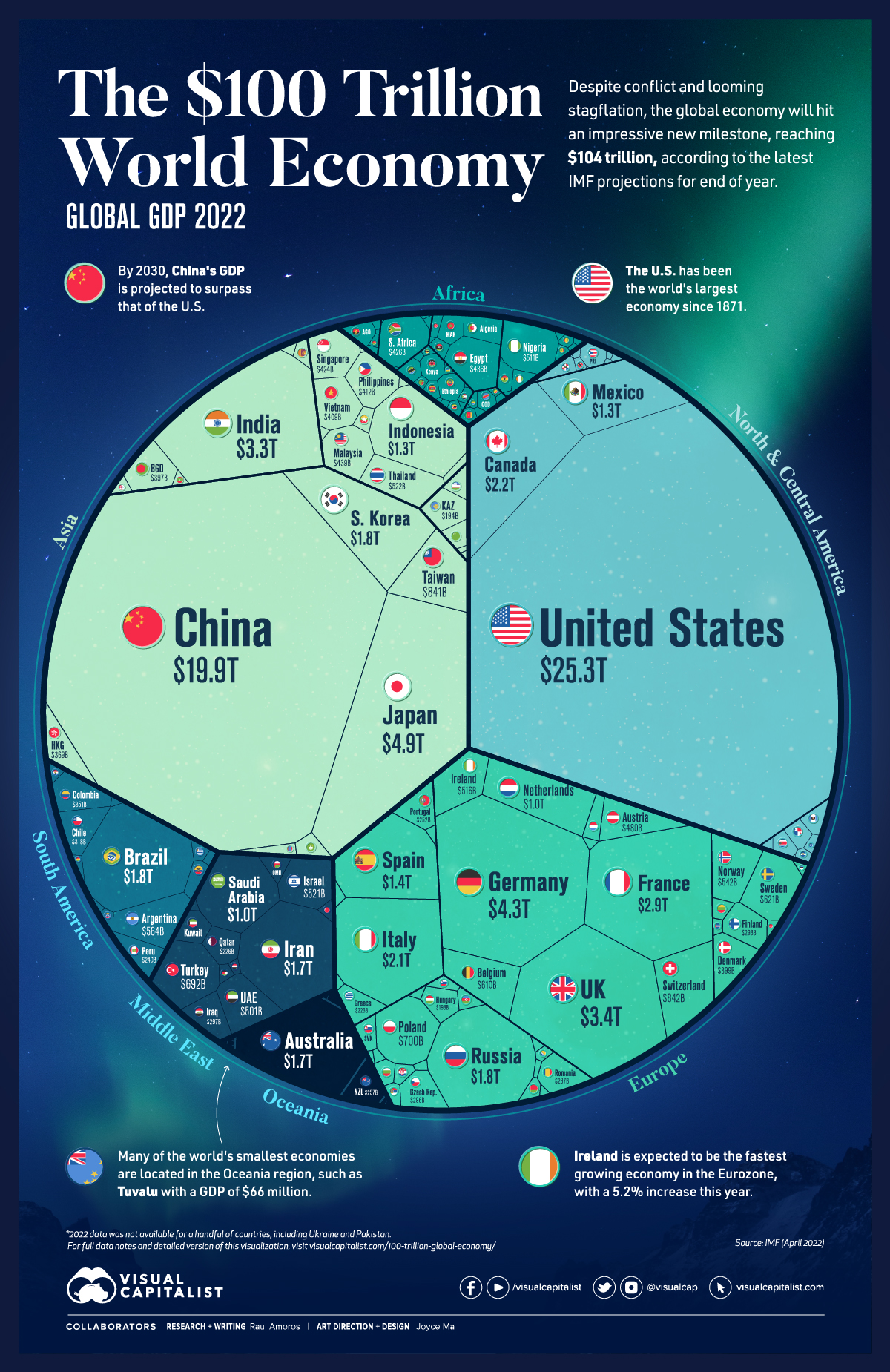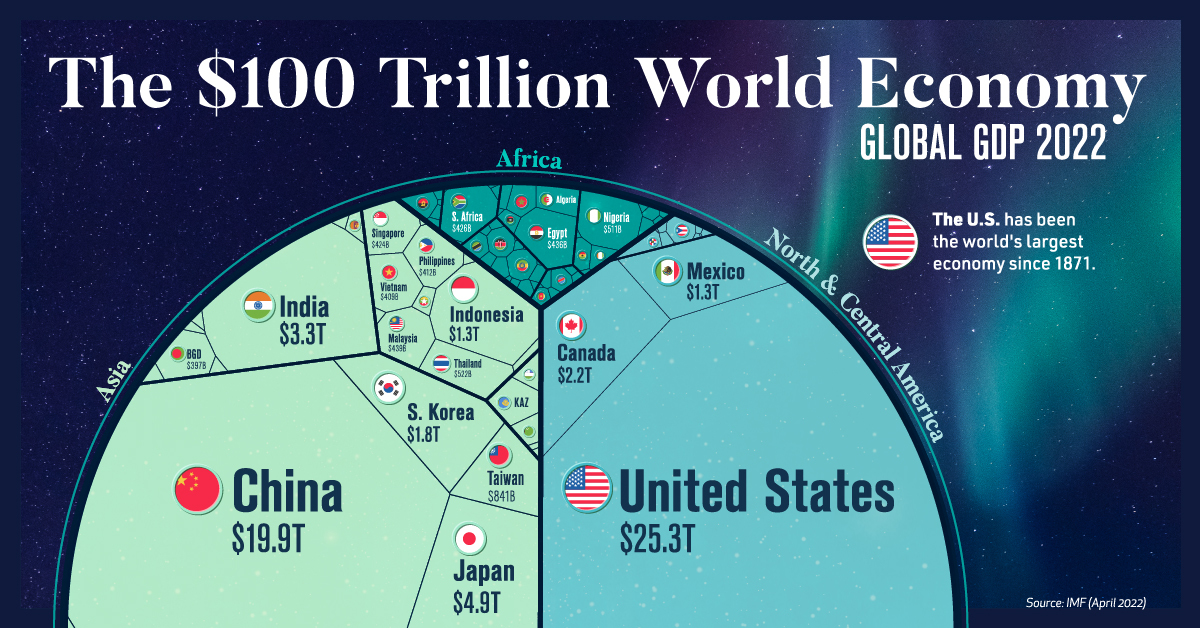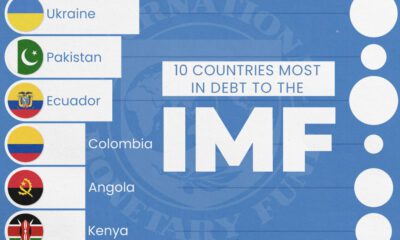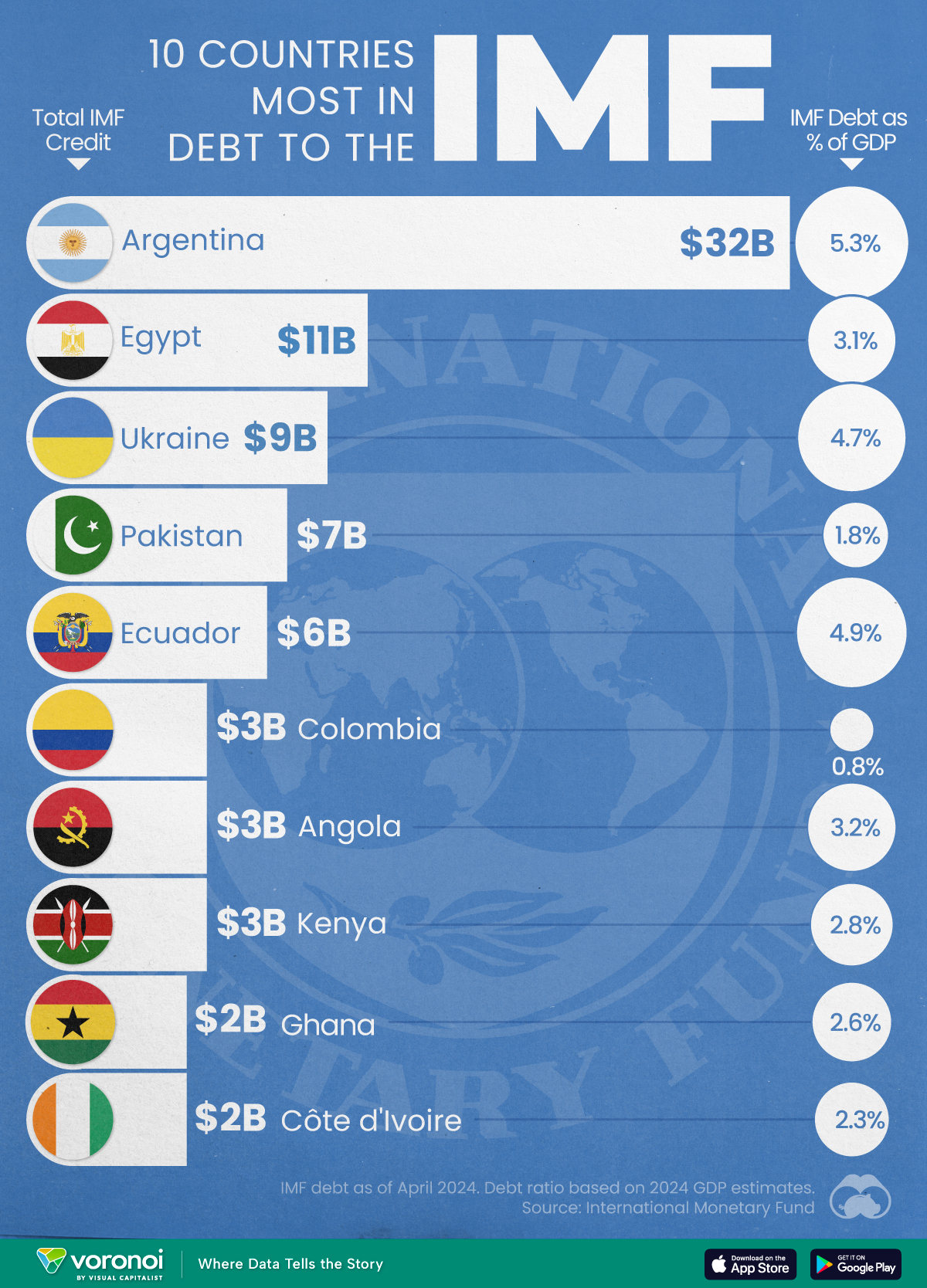Markets
The $100 Trillion Global Economy in One Chart
Check out the latest 2023 update of the global economy in one chart.
Visualizing the $100 Trillion Global Economy in One Chart
Check out the latest 2023 update of the global economy in one chart.
Surpassing the $100 trillion mark is a new milestone for global economic output.
We’ve covered this topic in the past when the world’s GDP was $88 trillion (2020) and then $94 trillion (2021), and now according to the latest projections, the IMF expects the global economy to reach nearly $104 trillion in nominal value by the end of 2022.
Although growth keeps trending upwards, the recovery that was expected in the post-pandemic period is looking strained. Because of recent conflicts, supply chain bottlenecks, and subsequent inflation, global economic projections are getting revised downwards.
Global annual GDP growth for 2022 was initially projected to be 4.4% as of January, but this has since been adjusted to 3.6%.
Note: This data from the IMF represents the most recent nominal projections for end of year as of April 2022.
The 50 Largest Economies in the World
The United States is still the economic leader worldwide, with a GDP of $25.3 trillion—making up nearly one quarter of the global economy. China follows close behind at $19.9 trillion. Here’s a look at the top 50 countries in terms of GDP:
| Rank | Country | GDP (current prices, USD) |
|---|---|---|
| #1 | 🇺🇸 United States | $25.3 trillion |
| #2 | 🇨🇳 China | $19.9 trillion |
| #3 | 🇯🇵 Japan | $4.9 trillion |
| #4 | 🇩🇪 Germany | $4.3 trillion |
| #5 | 🇬🇧 United Kingdom | $3.4 trillion |
| #6 | 🇮🇳 India | $3.3 trillion |
| #7 | 🇫🇷 France | $2.9 trillion |
| #8 | 🇨🇦 Canada | $2.2 trillion |
| #9 | 🇮🇹 Italy | $2.1 trillion |
| #10 | 🇧🇷 Brazil | $1.8 trillion |
| #11 | 🇷🇺 Russia | $1.8 trillion |
| #12 | 🇰🇷 South Korea | $1.8 trillion |
| #13 | 🇦🇺 Australia | $1.7 trillion |
| #14 | 🇮🇷 Iran | $1.7 trillion |
| #15 | 🇪🇸 Spain | $1.4 trillion |
| #16 | 🇲🇽 Mexico | $1.3 trillion |
| #17 | 🇮🇩 Indonesia | $1.3 trillion |
| #18 | 🇸🇦 Saudi Arabia | $1.0 trillion |
| #19 | 🇳🇱 Netherlands | $1.0 trillion |
| #20 | 🇨🇭 Switzerland | $842 billion |
| #21 | 🇹🇼 Taiwan | $841 billion |
| #22 | 🇵🇱 Poland | $700 billion |
| #23 | 🇹🇷 Turkey | $692 billion |
| #24 | 🇸🇪 Sweden | $621 billion |
| #25 | 🇧🇪 Belgium | $610 billion |
| #26 | 🇦🇷 Argentina | $564 billion |
| #27 | 🇳🇴 Norway | $542 billion |
| #28 | 🇹🇭 Thailand | $522 billion |
| #29 | 🇮🇱 Israel | $521 billion |
| #30 | 🇮🇪 Ireland | $516 billion |
| #31 | 🇳🇬 Nigeria | $511 billion |
| #32 | 🇦🇪 United Arab Emirates | $501 billion |
| #33 | 🇦🇹 Austria | $480 billion |
| #34 | 🇲🇾 Malaysia | $439 billion |
| #35 | 🇪🇬 Egypt | $436 billion |
| #36 | 🇿🇦 South Africa | $426 billion |
| #37 | 🇸🇬 Singapore | $424 billion |
| #38 | 🇵🇭 Philippines | $412 billion |
| #39 | 🇻🇳 Vietnam | $409 billion |
| #40 | 🇩🇰 Denmark | $399 billion |
| #41 | 🇧🇩 Bangladesh | $397 billion |
| #42 | 🇭🇰 Hong Kong SAR | $369 billion |
| #43 | 🇨🇴 Colombia | $351 billion |
| #44 | 🇨🇱 Chile | $318 billion |
| #45 | 🇫🇮 Finland | $298 billion |
| #46 | 🇮🇶 Iraq | $297 billion |
| #47 | 🇨🇿 Czechia | $296 billion |
| #48 | 🇷🇴 Romania | $287 billion |
| #49 | 🇳🇿 New Zealand | $257 billion |
| #50 | 🇵🇹 Portugal | $252 billion |
The frontrunner in Europe is Germany at $4.3 trillion, with the UK coming in second place. One significant change since the last reported figures is that Brazil now cracks the top 10, having surpassed South Korea. Russia falls just outside, in 11th place, with a GDP of $1.8 trillion.
While China’s GDP growth has slowed in recent years, projections still indicate that the country will overtake the U.S. by 2030, dethroning the world’s economic leader.
One region also expected to experience growth in the near future is the Middle East and North Africa, thanks to higher oil prices—Iraq and Saudi Arabia in particular are leading this charge. Regional GDP growth in the area is expected to be around 5% in 2022.
The 50 Smallest Economies in the World
Some of the world’s smallest economies were hit particularly hard by the pandemic, and have subsequently been the most affected by the inflation and food supply shortages resulting from the war in Ukraine.
Here’s a look at the countries worldwide with the lowest GDP in 2022:
| Rank | Country | GDP (current prices, USD) |
|---|---|---|
| #191 | 🇹🇻 Tuvalu | $66 million |
| #190 | 🇳🇷 Nauru | $134 million |
| #189 | 🇰🇮 Kiribati | $216 million |
| #188 | 🇵🇼 Palau | $244 million |
| #187 | 🇲🇭 Marshall Islands | $267 million |
| #186 | 🇫🇲 Micronesia | $427 million |
| #185 | 🇸🇹 São Tomé and Príncipe | $1 billion |
| #184 | 🇹🇴 Tonga | $1 billion |
| #183 | 🇩🇲 Dominica | $1 billion |
| #182 | 🇼🇸 Samoa | $1 billion |
| #181 | 🇻🇨 Saint Vincent and the Grenadines | $1 billion |
| #180 | 🇻🇺 Vanuatu | $1 billion |
| #179 | 🇰🇳 Saint Kitts and Nevis | $1 billion |
| #178 | 🇬🇩 Grenada | $1 billion |
| #177 | 🇰🇲 Comoros | $1 billion |
| #176 | 🇦🇬 Antigua and Barbuda | $2 billion |
| #175 | 🇬🇼 Guinea-Bissau | $2 billion |
| #174 | 🇸🇧 Solomon Islands | $2 billion |
| #173 | 🇸🇲 San Marino | $2 billion |
| #172 | 🇸🇨 Seychelles | $2 billion |
| #171 | 🇹🇱 Timor-Leste | $2 billion |
| #170 | 🇧🇿 Belize | $2 billion |
| #169 | 🇨🇻 Cabo Verde | $2 billion |
| #168 | 🇱🇨 Saint Lucia | $2 billion |
| #167 | 🇬🇲 The Gambia | $2 billion |
| #166 | 🇱🇸 Lesotho | $3 billion |
| #165 | 🇪🇷 Eritrea | $3 billion |
| #164 | 🇨🇫 Central African Republic | $3 billion |
| #163 | 🇧🇹 Bhutan | $3 billion |
| #162 | 🇸🇷 Suriname | $3 billion |
| #161 | 🇦🇼 Aruba | $3 billion |
| #160 | 🇦🇩 Andorra | $3 billion |
| #159 | 🇧🇮 Burundi | $3 billion |
| #158 | 🇱🇷 Liberia | $4 billion |
| #157 | 🇩🇯 Djibouti | $4 billion |
| #156 | 🇸🇱 Sierra Leone | $4 billion |
| #155 | 🇸🇿 Eswatini | $5 billion |
| #154 | 🇫🇯 Fiji | $5 billion |
| #153 | 🇲🇻 Maldives | $6 billion |
| #152 | 🇧🇧 Barbados | $6 billion |
| #151 | 🇸🇸 South Sudan | $6 billion |
| #150 | 🇲🇪 Montenegro | $6 billion |
| #149 | 🇹🇯 Tajikistan | $8 billion |
| #148 | 🇸🇴 Somalia | $8 billion |
| #147 | 🇹🇬 Togo | $9 billion |
| #146 | 🇰🇬 Kyrgyzstan | $9 billion |
| #145 | 🇲🇷 Mauritania | $9 billion |
| #144 | 🇽🇰 Kosovo | $10 billion |
| #143 | 🇲🇺 Mauritius | $11 billion |
| #142 | 🇲🇼 Malawi | $12 billion |
The smallest economy in the world measured in the IMF rankings is Tuvalu at $66 million. Most of the bottom 50 are considered low- to middle-income and emerging/developing countries. According to the World Bank, in developing countries, the level of per capita income in 2022 will be about 5% below the pre-pandemic trends.
Some countries are actually projected to experience negative GDP growth this year, particularly emerging and developing economies in Europe.
For example, Russia is expected to experience a GDP growth rate of -8.5% in 2022, though it still remains to be seen how the cost of war and increasingly harsh global sanctions impact the country’s economic prospects.
Inflation, Stagflation, Recession – How Bad is it?
While global economic growth has already been revised downwards, it’s possible the situation could be even more serious. Organizations like the World Bank say that risks of stagflation are rising. Stagflation, which hasn’t occurred since the 1970s, is defined as an economy that’s experiencing rising inflation combined with a stagnant economic output.
Currently, global consumer inflation is currently pegged at 7%. Daily goods are becoming increasingly difficult to purchase and interest rates are on the rise as central banks worldwide try to control the situation. As recent events in Sri Lanka demonstrate, low-income countries are particularly at risk to economic volatility.
Markets
Top 10 Countries Most in Debt to the IMF
Argentina tops the ranking, with a debt equivalent to 5.3% of the country’s GDP.
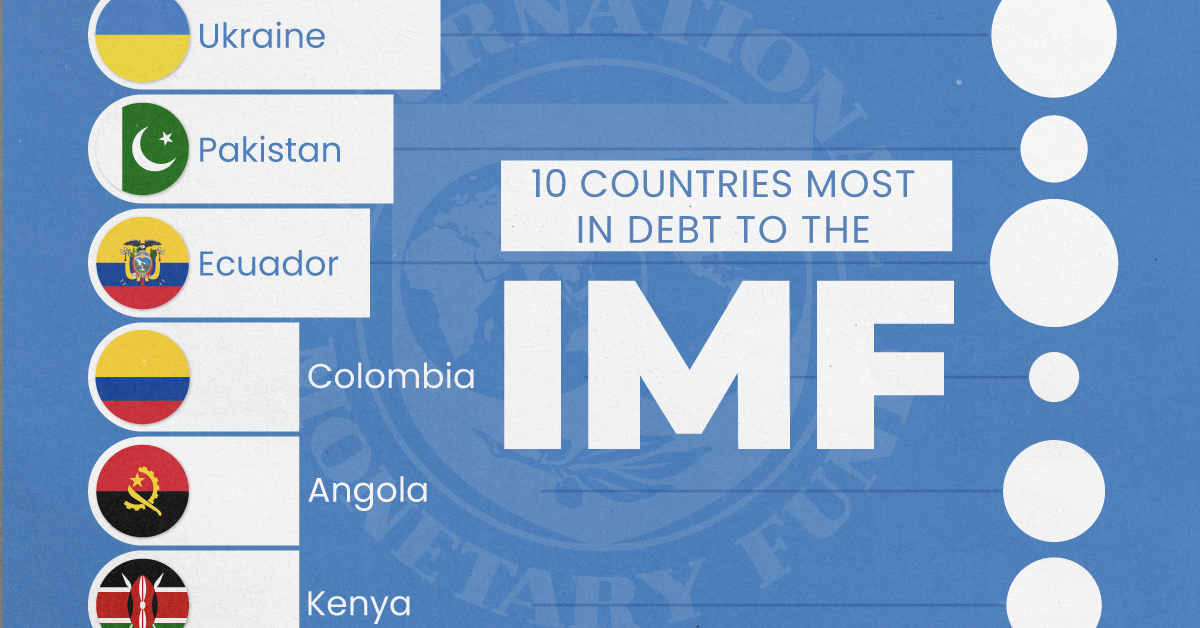
Top 10 Countries Most in Debt to the IMF
This was originally posted on our Voronoi app. Download the app for free on iOS or Android and discover incredible data-driven charts from a variety of trusted sources.
Established in 1944, the International Monetary Fund (IMF) supports countries’ economic growth by providing financial aid and guidance on policies to enhance stability, productivity, and job opportunities.
Countries seek loans from the IMF to address economic crises, stabilize their currencies, implement structural reforms, and alleviate balance of payments difficulties.
In this graphic, we visualize the 10 countries most indebted to the fund.
Methodology
We compiled this ranking using the International Monetary Fund’s data on Total IMF Credit Outstanding. We selected the latest debt data for each country, accurate as of April 29, 2024.
Argentina Tops the Rank
Argentina’s debt to the IMF is equivalent to 5.3% of the country’s GDP. In total, the country owns more than $32 billion.
| Country | IMF Credit Outstanding ($B) | GDP ($B, 2024) | IMF Debt as % of GDP |
|---|---|---|---|
| 🇦🇷 Argentina | 32 | 604.3 | 5.3 |
| 🇪🇬 Egypt | 11 | 347.6 | 3.1 |
| 🇺🇦 Ukraine | 9 | 188.9 | 4.7 |
| 🇵🇰 Pakistan | 7 | 374.7 | 1.8 |
| 🇪🇨 Ecuador | 6 | 121.6 | 4.9 |
| 🇨🇴 Colombia | 3 | 386.1 | 0.8 |
| 🇦🇴 Angola | 3 | 92.1 | 3.2 |
| 🇰🇪 Kenya | 3 | 104.0 | 2.8 |
| 🇬🇭 Ghana | 2 | 75.2 | 2.6 |
| 🇨🇮 Ivory Coast | 2 | 86.9 | 2.3 |
A G20 member and major grain exporter, the country’s history of debt trouble dates back to the late 1890s when it defaulted after contracting debts to modernize the capital, Buenos Aires. It has already been bailed out over 20 times in the last six decades by the IMF.
Five of the 10 most indebted countries are in Africa, while three are in South America.
The only European country on our list, Ukraine has relied on international support amidst the conflict with Russia. It is estimated that Russia’s full-scale invasion of the country caused the loss of a third of the country’s economy. The country owes $9 billion to the IMF.
In total, almost 100 countries owe money to the IMF, and the grand total of all of these debts is $111 billion. The above countries (top 10) account for about 69% of these debts.
-

 Maps7 days ago
Maps7 days agoMapped: Southeast Asia’s GDP Per Capita, by Country
-

 Markets2 weeks ago
Markets2 weeks agoVisualizing Global Inflation Forecasts (2024-2026)
-

 United States2 weeks ago
United States2 weeks agoCharted: What Southeast Asia Thinks About China & the U.S.
-

 United States2 weeks ago
United States2 weeks agoThe Evolution of U.S. Beer Logos
-

 Healthcare1 week ago
Healthcare1 week agoWhat Causes Preventable Child Deaths?
-

 Energy1 week ago
Energy1 week agoWho’s Building the Most Solar Energy?
-

 Markets1 week ago
Markets1 week agoMapped: The Most Valuable Company in Each Southeast Asian Country
-

 Technology1 week ago
Technology1 week agoMapped: The Number of AI Startups By Country

